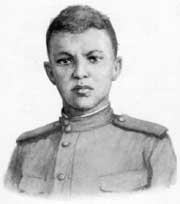Alexander Matrosov
| Alexander Matrosov | |
|---|---|
 | |
| Born |
5 February 1924 Yekaterinoslav (now Dnipro), USSR |
| Died |
27 February 1943 (aged 19) Chernushki, Loknyansky District, Pskov Oblast, USSR |
| Allegiance |
|
| Rank | Private |
| Awards |
|
Alexander Matveyevich Matrosov (Russian: Алекса́ндр Матве́евич Матро́сов; Bashkir: Шәкирйән Юныс улы Мөхәмәтйәнов, Ukrainian: Олександр Матвійович Матросов) (February 5, 1924 – February 22 or 27, 1943), born in Yekaterinoslav (now Dnipro) was a Soviet infantry soldier during the Great Patriotic War (Second World War), awarded the title of the Hero of the Soviet Union for blocking a German machine-gun with his body.
Official Soviet version
Matrosov was a private in the 254th Rifle Regiment within the 56th Guard Rifle Division of the Soviet Army. He was armed with a light machine-gun.[1]
On 22 February 1943, in the battle to recapture village of Chernushki, near Velikiye Luki, currently in Loknyansky District, Pskov Oblast, the Soviet forces struggled to take a German heavy machine-gun, housed within a concrete pillbox, which blocked the route to the village. It had already claimed the lives of many of the Russian troops. Matrosov crept up to the pillbox and released a burst of rounds into the slot in the pillbox. One round hit a mine inside, and the machine-gun temporarily fell silent. It restarted a few minutes later. At this point Matrosov physically pulled himself up and jammed his body into the slot, wholly blocking the fire at his comrades but clearly at the cost of his one life. This allowed his unit to advance and capture the pillbox and thereafter retake the village.
For his self-sacrifice in battle, Matrosov was posthumously awarded the distinction Hero of the Soviet Union and the Order of Lenin.[2]
Stalin officially renamed his regiment the Matrosov Regiment.[3]
Alternative versions
In post-Soviet times, a number of alternative versions were published, some of which suggested the event was inadvertent.[4][5][6]
M. J. Broekmeyer claims that Matrosov had been dragged in front of the post by the Germans when he tried to push down the barrel of the gun after having crawled up above the firing hole, and that his death was moved from February 27 to 22 to match the day of the creation of the Red Army.[7]
Similar cases
According to Chinese propaganda, Matrosov's tale also inspired Huang Jiguang, a famous Chinese revolutionary martyr, to perform a similar feat during the Korean War.[8]
In popular culture
Matrosov is the main character of the 1947 war film, Private Alexander Matrosov (Рядовой Александр Матросов), directed by Leonid Lukov.
References
- ↑ Soviet Calendar 1917-1947, Foreign Languages Publishing House, Moscow 1947
- ↑ Biography (Russian)
- ↑ Soviet Calendar 1917-1947, Foreign Languages Publishing House, Moscow 1947
- ↑ ""Александр Матросов. Правда о подвиге" — Россия, 2008". Archived from the original on 2012-02-11.
- ↑ Лазарь Ильич Лазарев (2001-05-07). "Когда мы вернулись с войны". Новая газета. Archived from the original on 2012-02-11. Retrieved 2010-05-14.
- ↑ Юрий Прохоров, "Правда о великой победе под Курском", Мегаполис, 2003, No 33
- ↑ M. J. Broekmeyer, Stalin, the Russians, and Their War: 1941-1945, University of Wisconsin Press, 2004, ISBN 0-299-19594-5, Google Print, p.206
- ↑ Matrosov Style Hero, Hung Jiguang (马特洛索夫式的英雄黄继光), Beijing: People's Daily, 1952-12-21, retrieved 2012-11-26
External links
| Wikimedia Commons has media related to Alexander Matrosov. |
- Image
- A monument to Alexander Matrosov, Moskovsky park of Victory, St. Petersburg